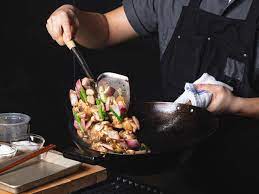
Introduction
Stir-frying” is arguably the most well-known technique in wok cooking—both within China and across the globe. But contrary to what some may practice, the method is a little more nuanced than tossing some meat and vegetables around in a wok, drowning them in soy sauce, and calling it a day. Stir-frying in a wok has a long history that traces back thousands of years, but only in the last few centuries has it developed into the technique that we know now. Let’s dig in.
Where Did Stir-Frying Come From?
The earliest evidence of the origins of the “stir-fry” technique comes from bronze inscriptions found on pots and cauldrons from the Eastern Zhou period (771-256 BC) in China, upon which the character (ch’ao; pinyin: chǎo) appears. Here, chao refers to “dry stirring,” indicative of the method used to dry grain in a wok. It wasn’t until the 6th century AD that “chao” was used more in line with the modern stir-frying technique, in the agricultural text Qimin Yaoshu’s recipe for scrambled eggs. “Chao” continued to appear sporadically in texts for the next several centuries, flipping back and forth between the two meanings of either a drying technique or a cooking method.
Stir-frying is more than just a cooking technique—it’s a fast, flavorful way to prepare balanced meals with fresh ingredients. Originating from Chinese cuisine, this method involves quickly cooking small pieces of food over high heat while constantly stirring. It’s perfect for busy cooks who want to create delicious dishes without spending hours in the kitchen. With the right tools, ingredients, and techniques, anyone can master stir-frying and enjoy restaurant-quality results at home. Whether you’re stir-frying veggies, meat, or tofu, this guide will teach you everything you need to know to perfect the art of stir-frying. If you learn these types of recipes, you can watch the classy kitchen’s best online cooking course in Bangalore.
Why Stir-Frying is a Must-Learn Cooking Technique
Stir-frying is a quick, versatile cooking method that locks in flavors and preserves the nutrients of ingredients. Popular in Asian cuisine, it allows you to prepare healthy and flavorful meals in minutes. With the right skills, stir-frying can become your go-to technique for easy weeknight dinners.
Stir-frying is a quick, high-heat cooking technique that involves tossing small, evenly cut ingredients in a hot pan. It ensures food is seared on the outside while staying tender on the inside, locking in both flavors and nutrients. Originating from Asian cuisines, stir-frying has become a favorite worldwide due to its versatility and speed.
With the right pan, ingredients, and some essential tips, you can transform simple items like vegetables, proteins, and noodles into vibrant, delicious meals. Mastering the art of stir-frying allows you to cook efficiently while maintaining the freshness and quality of each ingredient. Whether you’re cooking a savory chicken stir-fry or a vegetable medley, learning this method will bring new depth and excitement to your home-cooked meals.
1. Choose the Right Pan for Stir-Frying
Selecting the right pan is essential to mastering stir-frying. The ideal pan distributes heat evenly, retains high temperatures, and provides enough space for food to move freely. Here are the best options:
Carbon Steel Wok: The Traditional Choice
Cast Iron Wok: Great for Heat Retention
Non-Stick Skillet: A Beginner-Friendly Option
Stainless Steel Pan: Durable and Versatile
A carbon steel wok or a large non-stick skillet works best. These pans heat quickly and evenly, ensuring that every ingredient cooks perfectly.
Tip: Preheat the wok until it’s smoking hot before adding oil for better flavor and searing.
2. Use High-Quality Oils that Can Handle Heat
Since stir-frying involves high temperatures, you need oils with high smoke points. Peanut oil, canola oil, and avocado oil are ideal. Avoid olive oil, which can burn quickly.
Tip: Add the oil after the pan is hot to prevent it from breaking down and losing flavor.
3. Prep Ingredients in Advance
Preparation is crucial to achieving stirfry success. Stir-frying happens fast, often in just a few minutes, leaving little time for chopping or measuring during the cooking process. Prepping everything in advance ensures smooth cooking and perfect results.
Stir-frying happens fast, so all ingredients should be prepped before you start cooking. Slice vegetables thinly and evenly to ensure they cook uniformly. Meat or tofu should also be cut into bite-sized pieces.
Tip: Arrange ingredients in the order you’ll cook them—harder veggies like carrots go first, and softer ones like leafy greens go last.
4. Work in Batches to Avoid Overcrowding
Overloading the pan will lower the temperature, causing food to steam instead of stir-fry. For the best results, cook in small batches.
Tip: Wipe the pan between batches if it collects too much moisture.
5. Keep the Ingredients Moving Constantly
The key to a perfect stir-fry is constant motion. Use a spatula or tongs to toss the ingredients frequently, ensuring even cooking without burning.
Tip: Tilt the pan slightly to help toss food like a pro.
6. Balance Flavors with Sauces and Seasonings
A stir-fry isn’t complete without a flavorful sauce. Combine soy sauce, oyster sauce, hoisin, or chili sauce with a dash of sugar or vinegar for balance. For added depth, toss in aromatics like garlic, ginger, or scallions.
Tip: Add sauces towards the end to avoid burning and retain bold flavors.
7. Use Garnishes for Extra Flavor and Texture
Finish your stir-fry with fresh herbs, toasted sesame seeds, or crushed peanuts to elevate the dish. Garnishes add a burst of flavor and create a pleasing texture contrast.
Tip: Serve immediately over steamed rice or noodles for the best taste.
Conclusion: Stir-fry like a Pro Every Time
Mastering stir-frying is all about preparation, timing, and constant movement. With a hot pan, fresh ingredients, and the right technique, you can whip up delicious meals in minutes. Practice regularly, and soon you’ll be creating restaurant-quality stir-fries at home. You can see all the recipes in online cooking classes at home.
